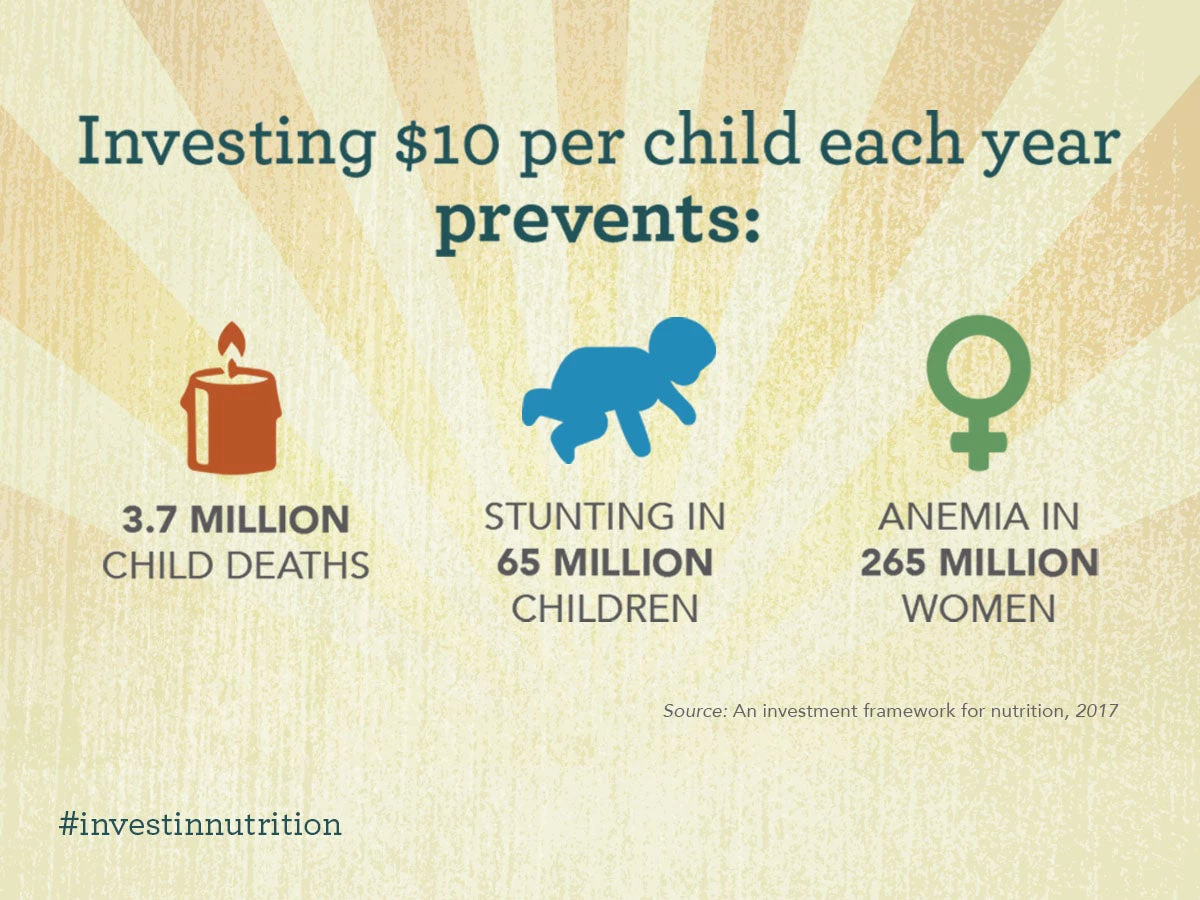“If breastfeeding did not already exist, someone who invented it today would deserve a dual Nobel Prize in medicine and economics.” - World Bank Vice President of Human Development, Keith Hansen
This is a sentiment long-shared by many of us in the nutrition community and as the global movement in nutrition grows, so does our body of evidence supporting how powerful nutrition interventions are for individuals and for societies.
We now know that interventions like improved nutrition for pregnant mothers, iron and folic acid supplementation for non-pregnant women, improved feeding practices including breastfeeding, improved child nutrition including micronutrient supplementation, pro-breastfeeding social policies and national campaigns, and staple food fortification, significantly reduce stunting in children, reduce anemia in women, save lives, and give massive returns on investment, up to $35 for every dollar spent. Investments in nutrition during the first 1,000 days, from pregnancy to a child’s second birthday, are not only among the smartest development investments, laying the groundwork for successful investments in other sectors, but will also pave the way for today’s children to drive tomorrow’s growing economies.
A new World Bank report, An Investment Framework for Nutrition, with inputs from Results for Development Institute and 1,000 Days, finds that investing $10 per child per year above current spending over the next decade is needed to achieve the global nutrition targets for stunting, anemia, breastfeeding and the scaling up of the treatment of severe wasting. Investing in nutrition-specific interventions to reach these targets by 2025 will have enormous impacts, including:
- 65 million cases of childhood stunting prevented in 2025
- 265 million cases of anemia in women prevented in 2025
- 91 million more children under five years of age would be treated for severe wasting
- 105 million additional babies would be exclusively breastfed during the first six months of life
- 3.7 million child deaths averted in 2025
In an environment of constrained resources where the world could not afford $7 billion per year over 10 years, priorities would need to be set. In addition to the full package, the Investment Framework for Nutrition also lays out two alternative packages that would kick-start ready-to-scale interventions and invest in understanding delivery platforms and more cost-effective strategies for scaling up interventions with bottlenecks in a more phased-in approach, with the strong caveat that neither package will reach all of the global targets by 2025. However, the impacts of these packages could still be significant.
- The priority “ready-to-scale” package, over 10 years, would cost $2.3 billion per year, save 2.2 million child lives and prevent childhood stunting in 50 million
- The catalyzing progress “phased-in” package over 10 years would cost $3.7 billion per year, save 2.6 million child lives and prevent childhood stunting in 58 million children
This report was initially launched at the 2016 World Bank Annual Meetings where a Human Capital Summit highlighted country commitment to investment in the Early Years from the Prime Minister of Cote d’Ivoire, and Finance Ministers of Cameroon, Ethiopia, Indonesia, Madagascar, Pakistan, Senegal, and Tanzania. As a follow up to the Human Capital Summit, a Spotlight on Nutrition event will be held at the World Bank-IMF Spring Meetings 2017 on the importance of nutrition as an investment to unlock human capital and economic prosperity. This high-level event will serve as another collective step forward as we work together to mobilize political commitment and financial resources towards achieving the Sustainable Development Goal of ending all forms of malnutrition by 2030.
Childhood years are limited, and each day that passes without action to address stunting and improve other nutrition outcomes diminishes the potential to save children’s lives, build future human capital and gray-matter infrastructure, and provide equal opportunity for all children to drive faster economic growth. Not only will these investments benefit the children directly affected but also benefit us all in the form of more robust and equal societies.
Related
Webcast: Spotlight on Nutrition
Publication: An Investment Framework for Nutrition




Join the Conversation